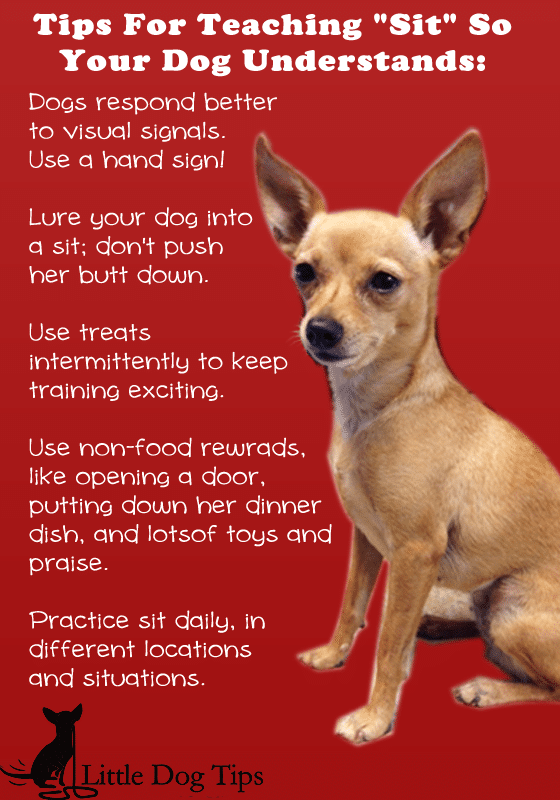
Sit is usually the first command people teach puppies, as well as older rescues and adoptees.
However, if your dog is long beyond being taught “sit” for the first time, but is failing to respond to the command consistently, it may be time to reteach sit in a new way – with a new command or hand signal.
Why Sit Matters
When you teach a dog, “sit,” for the first time, you light up a part of her brain. She discovers the power of cause and effect. She realizes your words have meaning, and learns to watch your body language for instructions on what to do next.
You can ask your dog to sit whenever she’s doing something undesirable. If she’s jumping on people to greet them, trying to steal your sandwich, or bothering the cat – an easy command like “sit” is the perfect way to get her to stop without scolding her, by instead telling her what to do instead.
Luring Into A Sit
To teach your dog to sit, you’ll use a technique known in the dog training world as “luring.”
You use a tasty treat that your dog will follow with her nose as you lure her into the correct position.
When your dog is standing, hold a treat near her nose, and slowly bring it upwards and backwards until she sits to reach it. The instant she sits, say, “Good dog!” or click a clicker, then allow her to eat the treat. After a few repetitions, you can begin to say, “Sit!” just once, just as she starts lowering her butt.
Many people make the mistake of repeating, “sit, sit, sit!” over and over before the dog even knows what it means. This can make it sound like chatter that your dog may learn to tune out as she focuses on the treat. Say it just once, and your dog will learn to associate the word with the action.
You can “reset” your dog by walking a few steps away. This can help her learn to sit anywhere – in the living room, by the couch, in the kitchen, and outside. However, you’ll likely end up with a dog that bounces back up right after sitting.
Sit Until Release
Have your dog sit, then give her five treats in a row, right after another. Wait one second, give her another. Wait two seconds, give her another. Say a release word, like “Okay!” then encourage her to stand.
Practice this randomly, and your dog will realize that it’s a good idea to stay seated in case there are more treats on the way, rather than bouncing back up.
Using Hand Signals
Dogs learn faster and respond better with hand signals, rather than verbal commands. A hand signal also makes it easier to communicate with your dog from a distance.
The universal hand signal for “sit” – start by standing with your arms by your sides. Raise one hand, palm upward, bending your arm at the elbow.
With a treat in your hand, you can easily start using this hand signal while simultaneously luring your dog into position.
If your dog already knows “sit,” but doesn’t respond to your verbal cue very well, teach the hand signal without verbalizing. Teach as though you’re starting anew.
Fading The Treat And Lure
Your dog doesn’t really know “sit” if you always have to hold a treat over her nose to get her to do it.
After your dog gets the hang of following the lure, try the hand signal with no treat in your hand. Give your dog at least 10 seconds to attempt a sit. If it doesn’t work, try the lure a few more times.
If it does, praise your dog and give her a treat.
After a few successful sessions with treats, ask your dog to sit and use non-treat rewards when your dog gets it right. Non-treat rewards include opening the door to let your dog out, a few seconds of tug with a toy, and placing your dog’s dinner bowl on the floor.
Once your dog is fluent in “sit,” start treating intermittently – yet, praise your dog every time she sits so she always knows that she has been successful.
Some dogs are dependent on receiving a treat to mark when they have successfully responded to a command. By only offering a treat reward some of the time, your dog will depend on your praise word or to confirm that they are correct.
Treats will always have a place in training. Your goal is not to fade them out completely. It’s payment for a job well done.



TRISHA
Tuesday 26th of February 2019
SUCH EXEMPLARY FACTS FOR PET LOVERS. LOVED THE POST. DIGITAL MARKETING COMPANY IN BANGALORE
Joy
Tuesday 8th of August 2017
Teaching your dog to sit is very important. This is because in the urban environment, there are several dangers that your dog may face especially if he is untrained. For example, your dog may run out into the traffic and end up getting hit by a car. So every dog owner needs to teach their dog to sit to ensure their safety. Thanks Lindsay for the information <3